Most life on Earth will be WIPED OUT in a billion years due to an extreme plunge in oxygen levels, scientists warn
- Researchers from Japan and the US modelled the future of Earth’s atmosphere
- Rising solar brightness will impact surface temperatures and photosynthesis
- This will cause rapid atmospheric deoxygenation in around a billion year’s time
- The finding has implications for how we search for habitable planets elsewhere
An extreme plunge in atmospheric oxygen levels will in a billion years’ time will wipe out most of the life on the Earth, a study has predicted.
Researchers from Japan and the US modelled how our planet’s atmosphere will change in light of various biological, climatic and geological processes.
Deoxygenation will result from the increasing flux of energy from the Sun as it brightens, increasing surface temperatures and reducing photosynthesis.
They found that deoxygenation in some one billion years will return the atmosphere to an inhospitable, methane-rich composition — one reminiscent of the early Earth.
This fate, they added, will occur before the arrival of so-called moist greenhouse conditions in which water will irreversibly leak from the planet’s atmosphere.
The findings suggest that atmospheric oxygen is not a permanent fixture of habitable planets, which has implications for our search for life on other worlds.
An extreme plunge in atmospheric oxygen levels will in a billion years’ time will wipe out most of the life on the Earth, a study has predicted. Pictured: the fall in oxygen the team predicted
Before 2.4 billion years ago, the Earth’s atmosphere was rich in methane, ammonia, water vapour and the noble gas neon, but lacked free oxygen.
This was introduced in an episode that geologists refer to as the Great Oxygenation Event, during which cyanobacteria living in the oceans started to produce significant amounts of oxygen via photosynthesis, thereby radically changing the atmosphere.
This influx of oxygen is credited with paving the way to support multicellular life on a broad scale, although such also came with a cost — the death of many anaerobic bacteria, in what is thought to have been Earth’s first mass extinction.
The new findings suggest that, in Earth’s future, the atmosphere could swing back the other way — and possibly give the world back to anaerobic microorganisms.
‘We find that future deoxygenation is an inevitable consequence of increasing solar fluxes,’ the research duo wrote in their paper.
‘Its precise timing is modulated by the exchange flux of reducing power between the mantle and the ocean–atmosphere–crust system.’
‘Our results suggest that the planetary carbonate–silicate cycle will tend to lead to terminally CO2-limited biospheres and rapid atmospheric deoxygenation.’
The oxygenation of the atmosphere is commonly seen as being indicative of Earth’s present biosphere, plants and photosynthetic activity. Therefore, the logic goes, we should look for similar oxygenated worlds in our hunt for extra-terrestrial life.
However, the findings suggest that — from the point of view of a hypothetical distant alien observer — the detection of atmospheric oxygen on Earth might only be possible for around two–three tenths of our planet’s lifetime.
If this is true for other planets as well, the researchers argue, we may need to adjust our search for life elsewhere in the universe to look for additional biosignatures, ones indicative of life persisting outside of a planet’s oxygen-rich period.
The full findings of the study were published in the journal Nature Geoscience.

